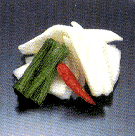 |
 |
Kyo Tsukemono
 Tsukemono was initially used as a process for pickling vegetables in salt for consumption during the winter or preharvest seasons and then eaten after the salt was removed. In the Nara period, miso, rice and soy
beans were used in pickling. However, it was not until the Kamakura period that pickled vegetables ?? and was eaten in Zen temples which maintained a vegetarian diet. In the medieval period, pickled vegetables such as umeboshi (pickled plums) and takuan (pickled radish) proved to be a popular garnish for okayu (rice gruel) and ochazuke (rice with tea).
Presently, there are over forty kinds of pickled vegetables made in Kyoto such as senmaizuke (thinly sliced and pickled turnip root) from Shogoin, suguki (tartly pickled turnip) from the Kamigamo area, shibazuke (pickled eggplatn) from Rakuboku Ohara, and nanohanazuke (pickled rape leaves). Known for its low sodium and tartness in flavor through fermentation, Kyozuke is a director product of the high quality vegetables and cool winter climate of Kyoto. Tsukemono was initially used as a process for pickling vegetables in salt for consumption during the winter or preharvest seasons and then eaten after the salt was removed. In the Nara period, miso, rice and soy
beans were used in pickling. However, it was not until the Kamakura period that pickled vegetables ?? and was eaten in Zen temples which maintained a vegetarian diet. In the medieval period, pickled vegetables such as umeboshi (pickled plums) and takuan (pickled radish) proved to be a popular garnish for okayu (rice gruel) and ochazuke (rice with tea).
Presently, there are over forty kinds of pickled vegetables made in Kyoto such as senmaizuke (thinly sliced and pickled turnip root) from Shogoin, suguki (tartly pickled turnip) from the Kamigamo area, shibazuke (pickled eggplatn) from Rakuboku Ohara, and nanohanazuke (pickled rape leaves). Known for its low sodium and tartness in flavor through fermentation, Kyozuke is a director product of the high quality vegetables and cool winter climate of Kyoto.
BACK


|
|